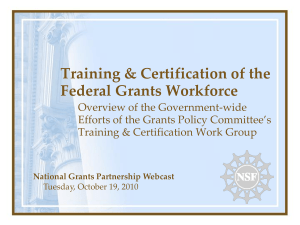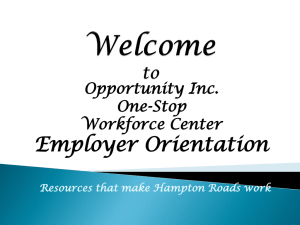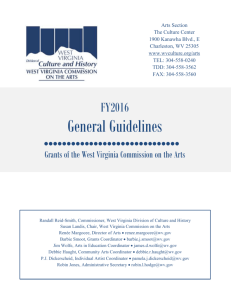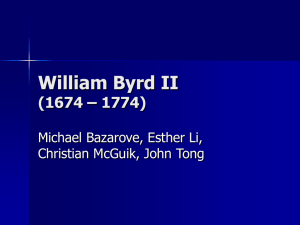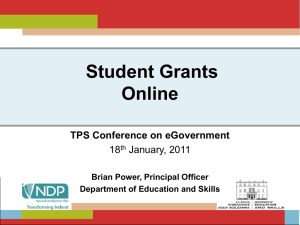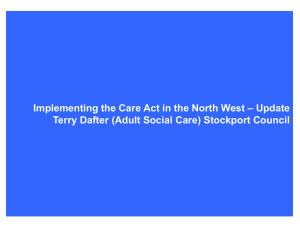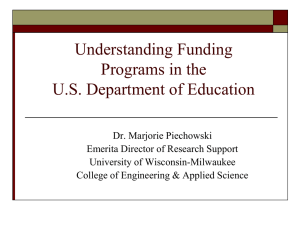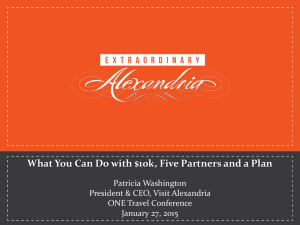Summit PowerPoint Presentation - Virginia Western Community
advertisement
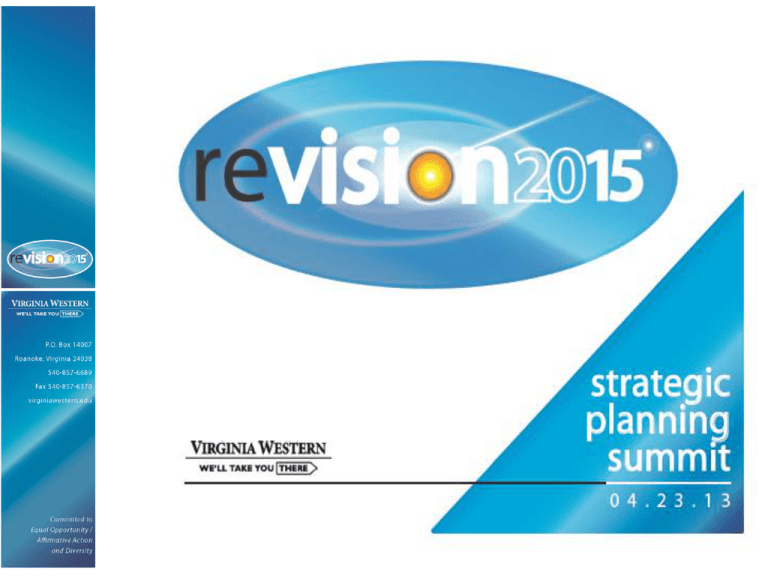
“We have a strategic plan. It’s called doing things.” - Herb Kelleher Co-founder, Southwest Airlines “Strategic planning will help you fully uncover your available options, set priorities for them, and define the methods to achieve them.” – Robert J. Mckain Bridging Vision 2013 with Achieve 2015 Revitalize and Reenergize Virginia Community College System Six Year Strategic Plan: 2009-15 Access -- Affordability -- Student Success Workforce -- Resources Virginia Western Community College Five Year Strategic Plan: 2008-13 Integrity -- Excellence -- Service -Community 2014 Reaffirmation SACS, where Students Are Central to Success Institutional Effectiveness Implementation Cycle ReVISION 2015 Adjustments and Resource Requests Evaluate, Review and Improve “Close the Loop” on the Assessment Cycle Feedback from Stakeholders, Students, Faculty, Graduates, Employers, Transfer Institutions, Community Institutional Mission And Strategic Goals Institutional Success Implement Plans And Conduct Assessment Budget Allocations College Divisions Mission and Purpose Action Plans Student Learning Outcomes Administrative and Educational Support Outcomes QEP:Team Advising Shared Vision, Values, and Strategy One day Alice came to a fork in the road and saw a Cheshire cat in a tree. “Which road do I take? she asked. His response was a question: “Where do you want to go?” “I don’t know,” Alice answered. “Then,” said the cat, “it doesn’t matter.” -Lewis Carroll, Alice in Wonderland www.youtube.com/watch?v=RRIOc7RQ93g&list=PL34F57B80D290E95D Purpose of Strategic Plan Affirm the College vision, mission and core values Serves as a roadmap for the College’s future Develop action plans to implement the Strategic Plan Today’s Goals Review strategic input Reaffirm the College’s vision, mission and institutional goals Review the planning and assessment process Strategic Input Key Current and Emerging Initiatives Impacting Virginia Western’s Future Report From the 21st-Century Commission on the Future of Community Colleges Data and Trend Analysis Report Virginia Western Quick Facts SWOT Analysis Key Current and Emerging Issues College costs and access Student success (completion agenda) Student engagement Increased focus on institutional accountability Services and skills for Baby Boomers Key Current and Emerging Issues Resources Keeping up with technology Managing crisis Workforce Developmental education Key Current and Emerging Issues Dual enrollment Increased response to globalization Sustainability Diversity of articulation agreements Alternative pathways to the baccalaureate www.youtube.com/watch?v=JJ1jMUaHJso Framework of Institutional Responses Needed to Move Community Colleges Ahead Move From Move To A focus on student access A focus on access and student success Fragmented course-taking Clear, coherent educational pathways Low rates of student success High rates of student success Tolerance of achievement gaps Commitment to eradicating achievement gaps A culture of anecdote A culture of evidence Individual faculty prerogative Collective responsibility for student success A culture of isolation A culture of collaboration Emphasis on boutique programs Effective education at scale A focus on teaching A focus on learning Information infrastructure as management support Information infrastructure as learning analytics Funding tied to enrollment Funding tied to enrollment, institutional performance, and student success Source: Reclaiming the American Dream: Community st Colleges and the Nation’s Future. A Report From the 21 Century Commission on the Future of Community Colleges. 2012 Data and Trend Analysis Report Highlights Demographics (Roanoke MSA) Population: 309,802 Age Fastest growing age groups are the ages of 55-69 Population of traditional young adults is projected to be flat or slightly negative. Population over 65 expected to grow over 70% between 2010-2040 Enrollments are down in high school and middle schools, and are anticipated to decline 5.4% over the next 5-years Ethnicity International population is increasing faster in our service area than in Virginia Hispanic population is up nearly 200% from 2000-2010 Income and Technology Income Nearly 20% of the population of Roanoke City live in poverty, versus 13% for the Roanoke MSA The median family income in Roanoke City is less than 75% of the US Median Family Income Technology Nearly one-third of households do not have computer access 36% do not have Internet access Employment Trends Projected employment cluster growth: Advanced manufacturing & skilled production Electrical equipment manufacturing Healthcare Business and financial Distribution Projected high levels of annual openings in: Office and administrative Sales Food preparation and serving Transportation and material moving Healthcare practitioners Technical production Student Trends Incoming students require additional educational support Increased need for ESL training Growth in distance learning headcounts and FTE Dual enrollment growth has stalled. (This could change, with CCAP and cost-free dual enrollment.) Career and technical program enrollments declined significantly in 2012 Developmental enrollments are high (>150% increase 2005-2012) More students at VWCC receive financial aid than state-wide, and receive more financial aid. Enrollment growth is highest for Botetourt County and Franklin County Report Suggestions Increase educational opportunities for plus 50 entrepreneurship and other courses of interest to the plus 50 population Consider jobs incubators and accelerator concepts such as found in Asheville, N.C. Expand technical programs such as Mechatronics “The labor pipeline for advanced production appears to need development” Enhance STEM-H training programs Encourage youth to pursue careers in the technical fields Find ways to increase demand for enrollment among nontraditional populations SWOT Analysis Strengths: Internal attributes that are helpful in achieving the mission What does Virginia Western do well? Weaknesses: Internal attributes that are harmful to achieving the mission What are Virginia Western’s weaknesses? SWOT Analysis Opportunities: External conditions that are helpful to achieving the mission What are the opportunities for growth and programming? Threats and Competition: External conditions that are harmful to achieving the mission What are the threats and competition to Virginia Western’s continued success? Strengths Questions to ponder: 1) 2) 3) 4) What advantages do we have? What do we do better than anyone else? What unique resources do we have access to? What do individuals living in our service-area see as our strengths? Weaknesses Questions to ponder: 1) What could we improve? 2) What should we avoid? 3) What are individuals living in our service-area likely see as our weaknesses? Opportunities Questions to ponder: 1) What opportunities do we know about, but have not been able to address? 2) Are there key current and emerging trends on which we can capitalize? Threats Questions to ponder: 1) 2) 3) 4) What external roadblocks exist that block our progress? Are our competitors doing anything different? Is there significant change coming in the education sector? Are economic conditions affecting our financial viability? Questions to Ponder 1) What business are we in and why? 2) Where are we going? 3) What do we stand for as an institution? Vision AS A STUDENT-ORIENTED CENTER for lifelong learning, Virginia Western Community College will meet demands of our diverse community by providing comprehensive educational programs and workforce development. Mission VIRGINIA WESTERN COMMUNITY COLLEGE provides affordable, accessible, and quality educational opportunities and workforce training to meet individual, community and global needs. Core Values Integrity MAINTAIN the highest standards of honesty, fairness and ethical conduct Excellence ENCOURAGE our students, faculty, and staff to strive for academic, professional, and personal excellence PURSUE continuous improvement and high quality in staffing, facilities, programs and services Core Values Service FOSTER a community that demonstrates care and support for students, faculty, staff, and the citizens of our service region PROMOTE service to others Core Values Community RESPECT and appreciate all cultures, learning styles, and ideas that reflect the community we serve PROVIDE access to services and programs for all students who may benefit PROMOTE a safe and secure environment that facilitates student learning Institutional Goals Will this goal: Help us financially? Improve the quality of what we do? Improve our relationships, partnerships or image? Improve the skills and capabilities of our team? Move us toward our strategic priorities? Institutional Goals Goal 1: Promote effective teaching and learning through quality instruction, programs, and services designed to meet the needs of a diverse student body. Goal 2: Cultivate relationships and partnerships with the educational community, business, industry, and government to create educational and workforce development opportunities to support economic vitality. Institutional Goals Goal 3: Practice sound stewardship of financial, physical, and technological resources to support high quality programs and services. Goal 4: Foster a safe and secure campus environment that is conducive to learning. Institutional Effectiveness Implementation Cycle ReVISION 2015 Adjustments and Resource Requests Evaluate, Review and Improve “Close the Loop” on the Assessment Cycle Feedback from Stakeholders, Students, Faculty, Graduates, Employers, Transfer Institutions, Community Institutional Mission And Strategic Goals Institutional Success Implement Plans And Conduct Assessment Budget Allocations College Divisions Mission and Purpose Action Plans Student Learning Outcomes Administrative and Educational Support Outcomes Planning and Assessment Overview Process Established in: Assessed Through: VWCC Mission Statement Strategic Plan Goals Strategic Plan Institutional Core Indicators IE Plans IE Assessment Reports IE Plans IE Assessment Reports Division Goals Department / School Objectives Academic Assessments VCCS Standards and VWCC input Gen Ed Assessments Program Reviews Core Indicators Example Goal 2: Cultivate relationships and partnerships with the educational community, business, industry, and government to create educational and workforce development opportunities to support economic vitality. Indicator Measure Justification Target for 2012-13 Year 3 10-11 Year 4 11-12 INSTITUTIONAL ADVANCEMENT Private Fundraising Increase private fundraising totals Total grant awards Grants # of grants submitted # of Collaborative grants (Career Pathways) Pres Goal #14 2012-13 Achieve 2015 Achieve 2015 Pres Goal #15 2012-13 10% increase 1.3% $ $852,147 $862,985 10% increase 77.8% 56.3% million $ $1.60 $2.50 10% increase 85.0% # 20 37 Increase 3 4 How do all of these pieces fit together in an Institutional Effectiveness Plan? Vision 2013 Institutional Goals Goal 1: Promote effective teaching and learning through quality instruction, programs, and services designed to meet the needs of a diverse student body. Goal 2: Cultivate relationships and partnerships with the educational community, business, industry, and government to create educational and workforce development opportunities to support economic vitality. Goal 3: Practice sound stewardship of financial, physical, and technological resources to support high quality programs and services. Goal 4: learning. Foster a safe and secure campus environment that is conducive to 2011-12 Grants IE Plan How does the department support institutional goals? Purpose: The Grants Development and Special Projects department at Virginia Western Community College develops and manages externally funded projects to further the mission, goals and strategic plan of the College. Relates to Institutional Goal: Goal 2: Cultivate relationships and partnerships with the educational community, business, industry, and government to create educational and workforce development opportunities to support economic vitality. Vision 2013 IA Division Goals Goal 1: Advance and promote interaction with alumni . . . Goal 2: Expand and refine communication and information dissemination with all internal and external constituencies . . . Goal 3: Strengthen Institutional Advancement by expanding and refining a comprehensive public/private grants development program. Goal 4: Expand the College’s general endowment . . . How does the department support division goals? Purpose: The Grants Development and Special Projects department at Virginia Western Community College develops and manages externally funded projects to further the mission, goals and strategic plan of the College. Relates to Institutional Goal: Goal 2: Cultivate relationships and partnerships with the educational community, business, industry, and government to create educational and workforce development opportunities to support economic vitality. Relates to Division Goal: Goal 3: Strengthen Institutional Advancement by expanding and refining a comprehensive public/private grants development program. What does the department do to support institutional and division goals? Purpose: The Grants Development and Special Projects department at Virginia Western Community College develops and manages externally funded projects to further the mission, goals and strategic plan of the College. Relates to Institutional Goal: Goal 2: Cultivate relationships and partnerships with the educational community, business, industry, and government to create educational and workforce development opportunities to support economic vitality. Relates to Division Goal: Goal 3: Strengthen Institutional Advancement by expanding and refining a comprehensive public/private grants development program. Objectives: Increase additional funds received through grant funding. Grant reporting will be completed by allotted deadlines. How will the department measure these objectives? Objectives: Increase additional funds received through grant funding. Grant reporting will be completed by allotted deadlines. Assessment Measures: Amount of grants received (total funding) Percentage of grants funded Percent of time grant reports completed on time How will the department know that it is achieving its objectives? Objectives: Increase additional funds received through grant funding. Grant reporting will be completed by allotted deadlines. Assessment Measures: Amount of grants received (total funding) Percentage of grants funded Percent of time grant reports completed on time Standards for Success: Total funding 1 million. 65% of grants will be funded. Grant reports to be completed with at least a 90% on-time rate. What will the department do to achieve its objectives? Implementation Plan: Complete development and implementation of grants database. Review and update grants management handbook, and training. What will the department do with the information gained? Dissemination/Discussion: Established benchmarks and grant reporting rates will be disseminated to the President. Strategic Planning Timelines Vision 2013 ReVision 2015 (New Plan) Virginia Western Strategic Plans (New Plan) Achieve 2015 VCCS Strategic Plans 2008 2014 2016 2021 Next Steps Update Division Goals Update Non-academic and Academic IE Plans Assessment Reports for 2012-13 –ALL MUST BE COMPLETE BEFORE SACSCOC ON-SITE VISIT ! Timeline for IE Plans and Assessments May – Student Services Summer – Non-academic Areas August – Academic Programs October 1-3, 2013: SACSCOC On-Site Evaluation “However beautiful the strategy, you should occasionally look at the results.” – Winston Churchill

